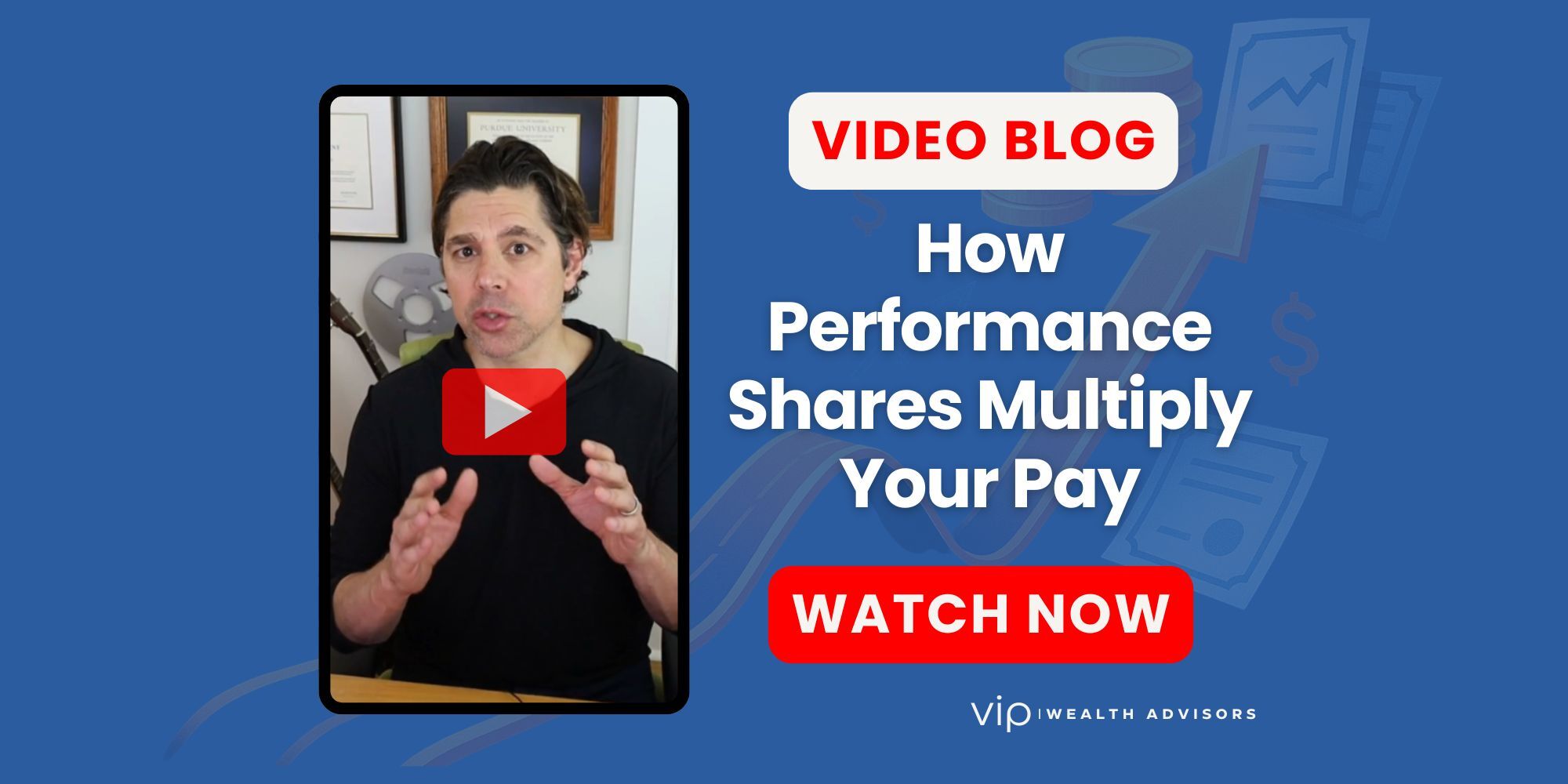- PSUs only pay if performance goals are met over a multi-year period (typically 3 years).
- Payouts scale with results (commonly 0% to 200% of target) based on metrics like EPS growth and relative TSR.
- Delivery triggers ordinary income tax at vest/settlement; no 83(b) election.
- Know the plan design: metrics, weights, payout curve, post-performance vesting, dividend equivalents.
- Model best/target/worst cases; plan diversification and liquidity ahead of settlement.
- Compare PSUs to RSUs/options: higher alignment and potential consistency, but risk of zero payout.
- Review change-in-control & holding requirements and state tax overlays before counting the cash.
In today's corporate world, compensation isn't just about a salary and bonus. For senior executives, tech leaders, and top-performing professionals, a growing share of wealth comes from equity-based incentives, and one type of award is increasingly defining how performance and pay intersect: performance shares.
Once limited to CEOs and top-tier leadership, performance-based stock grants are now appearing further down the organizational chart, particularly in fast-growing public companies and later-stage private firms seeking to align rewards with long-term success.
But what exactly are performance shares? How do they work? How are they taxed? And most importantly, how should you plan around them?
This article breaks down the structure, value, and planning implications of performance share units (PSUs) and related awards so you can make the most of your company's long-term incentive plan.
🔍 What Are Performance Shares?
Performance shares (often called performance stock units or PSUs) are a form of equity compensation that rewards you only if specific performance goals are achieved over a defined period, usually three years.
Unlike restricted stock units (RSUs), which typically vest based on continued employment, performance shares are earned only when your company meets specific financial or market-based targets.
In other words, no results, no shares.
Common performance metrics include:
- Earnings per share (EPS) growth
- Total shareholder return (TSR), often relative to peers
- Revenue growth or profit margins
- Return on equity (ROE) or return on assets (ROA)
- Strategic milestones, such as product launches or regulatory approvals
When the performance period ends, the company measures actual results against the preset goals. Depending on that outcome, you'll receive anywhere from 0% to 200% of your target shares (sometimes even higher, depending on the plan).
⚙️ How Performance Shares Work
Step 1: Grant and Target Award
You're granted a target number of performance shares, say 2,000, as part of your company's Long-Term Incentive Plan (LTIP). These shares aren't issued yet. Instead, they're a potential award based on future performance.
Step 2: Performance Measurement
Your company defines one or more metrics, for example:
- 3-year EPS growth of 10% annually, and
- Relative TSR at or above the 75th percentile of peer companies
Each metric may carry a weighting (e.g., 50% EPS, 50% TSR).
Step 3: Payout Formula
At the end of the 3 years, results are measured.
- Below threshold: No shares vest.
- At target: You earn 100% of your target shares (2,000 in this example).
- Above target: You may earn more, often up to 150%–200% of the target.
The performance curve is designed to scale rewards in proportion to achievement.
Step 4: Delivery and Settlement
If goals are met, shares are issued (or “settled”) to you; sometimes after an additional time-based vesting period to encourage retention.
The shares are then taxed as ordinary income when they're delivered.
🧩 Key Design Features of Performance Share Plans
Every company's plan is unique, but several common design elements shape the value and risk of performance share grants.
1. Measurement Period
Usually three years, aligning with the company's long-term strategic plan. Some firms use rolling cycles, granting new PSUs annually with overlapping measurement windows.
2. Performance Metrics
Metrics can be absolute (achieve X% EPS growth) or relative (beat the industry median TSR). Many companies use a combination to balance internal execution and market competitiveness.
3. Sliding Scale or Leverage
Performance shares often include a payout range, with scaling between the threshold, target, and maximum performance levels. This creates both upside potential and downside risk.
| Performance Level | Achievement | Payout % of Target |
|---|---|---|
| Below Threshold | < 80% of goal | 0% |
| Target | 100% of goal | 100% |
| Maximum | 120%+ of goal | 200% |
4. Post-Performance Vesting
Even after performance goals are met, companies may impose a holding or service period before shares are fully vested and transferable.
5. Dividend Equivalents
While you typically don't receive dividends during the performance period, some plans credit dividend equivalents that are paid out if and when the award vests.
🧠 Example: EPS-Based Performance Share Grant
Imagine your company grants you 2,000 PSUs with a three-year performance period tied to earnings per share (EPS) growth:
| Year | Target EPS | Actual EPS | Payout Multiplier |
|---|---|---|---|
| 2023 | $5.00 | $5.30 | +6% |
| 2024 | $5.50 | $5.80 | +5% |
| 2025 | $6.00 | $6.40 | +7% |
Cumulative EPS growth = 18%, versus a target of 15%. That places results at 120% of the goal, earning a 1.2x multiplier.
You'd receive 2,400 shares (2,000 × 1.2) at the end of the cycle, assuming continued employment.
🔄 Performance Shares vs. Restricted Stock and RSUs
It's easy to confuse performance shares with RSUs or restricted stock, but there are key distinctions that affect both value and risk.
| Feature | Restricted Stock / RSUs | Performance Shares (PSUs) |
|---|---|---|
| Issued at Grant | Yes (restricted until vesting) | No (earned upon goal achievement) |
| Vesting Trigger | Time or continued service | Company performance metrics |
| Value Certainty | Always some value if stock > $0 | May be worth zero if goals are missed |
| Primary Purpose | Retention | Pay-for-performance alignment |
| Investor View | Seen as guaranteed equity | Seen as a performance-driven reward |
Bottom line: RSUs reward you for staying. Performance shares reward you for results.
🧩 The Gray Zone: Performance-Based Restricted Stock
Not all companies cleanly separate “performance shares” from “restricted stock with performance vesting.”
For instance:
- Performance-Contingent Restricted Stock grants shares upfront but delays vesting until performance goals are met.
- Performance-Accelerated Restricted Stock vests over time but can vest early if performance triggers are hit.
Some companies even label these as “performance shares” in filings, blurring the terminology.
For example, a proxy statement might read:
“Executives receive restricted stock that vests only if three-year cumulative EPS targets are achieved. We refer to these as performance shares.”
This reinforces the need to review your specific grant agreement, not just the summary, to understand vesting terms, measurement mechanics, and payout conditions.
📈 Why Companies Love Performance Shares
-
Investor Alignment
Investors want executives to be rewarded for creating real shareholder value, not just for staying employed or riding a bull market.
Performance shares link compensation to metrics that investors care about, such as profit growth, returns on capital, and peer-relative stock performance. -
Governance Optics
Boards and compensation committees like performance shares because they demonstrate responsible pay design. Proxy advisory firms such as ISS and Glass Lewis also favor performance-based awards. -
Recruitment & Retention
While stock options and RSUs remain important, performance shares add a long-term incentive that aligns leadership behavior with sustainable results. -
Tax & Accounting Advantages
Under FASB ASC 718 (formerly FAS 123R), companies record a fixed expense at the grant date based on fair value, rather than using variable accounting. If goals aren't met, the expense can be reversed, improving earnings optics.
This accounting predictability has fueled the widespread adoption of PSUs. -
Perceived “Better Deal” Than Options
When modeled using realistic stock growth assumptions, target-level PSUs often have higher after-tax value than comparable stock options.
Executives don't need massive share-price appreciation to earn value; just solid, measurable company performance.
💡 Financial Planning Considerations
For executives and key employees, performance shares can represent significant potential upside but also complexity. Here's how to think strategically:
-
Scenario Modeling
Work with your advisor to model best-case, target, and below-threshold outcomes. This helps quantify the impact of PSUs on your long-term wealth plan. -
Diversification Planning
Since payout depends on company performance, your concentration risk may already be high. Plan early for how you'll diversify once shares vest and settle. -
Tax Timing
Performance shares are typically taxed as ordinary income when they vest and deliver, based on the fair market value of the shares at that time. No Section 83(b) election applies because shares aren't granted upfront. Your advisor should work to optimize withholding, estimated payments, and the timing of sales. -
Retention Periods
Some companies impose a post-vesting holding requirement (e.g., 1 year or until a multiple of salary is held in company stock). Make sure you understand these restrictions before assuming liquidity. -
Exit or M&A Scenarios
Review what happens to unvested PSUs in a merger or acquisition; they may accelerate, convert, or be forfeited depending on the plan's “change-in-control” provisions.
🌎 The Global Trend
Outside the U.S., particularly in the U.K. and Europe, performance shares have long been a standard component of executive pay programs. U.S. companies have since followed suit, making PSUs almost mandatory for senior leadership at public firms.
Now, mid-level executives and high-impact contributors are also receiving performance shares, bringing this once “C-suite only” benefit to a broader professional base.
🧭 Key Takeaways
- Performance shares tie pay to performance, not tenure.
- They can offer a greater upside than RSUs or options, but also carry a risk of zero payout.
- Each company's plan is different; your grant agreement defines the rules.
- Taxation occurs at vesting/delivery, not grant.
- These awards signal alignment between executives, investors, and long-term corporate goals.
For professionals navigating complex compensation packages, particularly those that combine RSUs, stock options, and PSUs, integrated planning across tax, investment, and equity strategy is crucial.
At VIP Wealth Advisors, we help clients translate these complex structures into actionable financial decisions, so your equity compensation works as hard as you do.
🏁 Takeaway: Make Performance Work for You
Performance shares are redefining how executives and professionals are rewarded, shifting the focus from stock price appreciation to sustainable business performance.
Understanding how your PSUs fit into your broader financial picture, including taxes, diversification, and retirement goals, can unlock their full potential.
At VIP Wealth Advisors, we specialize in helping high-income professionals and executives integrate equity compensation into a cohesive wealth strategy. If your compensation package includes performance shares, RSUs, or stock options, we can help you translate those complex grants into a clear financial roadmap.
💬 Performance Share FAQs
Q: What's the difference between PSUs and RSUs?
Q: How are performance shares taxed?
Q: What happens if I leave the company before performance shares vest?
Q: Can PSUs be paid in cash instead of stock?
Q: Do performance shares pay dividends?
Q: Are PSUs better than stock options?
📊 Turn PSUs Into A Real Plan
We help tech professionals, executives, and equity-rich leaders translate performance awards into a tax-smart, diversified wealth strategy.
View More Articles by Topic
- Taxes (73)
- Financial Planning (39)
- Equity Compensation (32)
- Investments (22)
- RSU (21)
- Tax Policy & Legislation (18)
- Business Owner Planning (14)
- Incentive Stock Options (14)
- Retirement (13)
- Psychology of Money (10)
- Real Estate (9)
- AMT (8)
- Alternative Investments (8)
- Pre-IPO Planning (8)
- Estate Planning (7)
- NSOs (6)
- The Boring Investment Strategy (6)
- Capital Gains Tax (5)
- Crypto (5)
- Fiduciary Standard (5)
- QSBS (5)
- Post-IPO Tax Strategy (4)
- 401(k) Strategy (3)
- Private Investments (3)
- Q&A (3)
- ETF Taxes (2)
- IRA Strategy (2)
- Irrevocable Trust (2)
- Legacy Wealth (2)
- Market Insights (2)
- Market Timing (2)
- Stock Market (2)
- Venture Capital (2)
- Video (2)
- AUM vs Flat Fee (1)
- Altruist (1)
- Atlanta (1)
- Book Review (1)
- Charitable Giving (1)
- Education Planning (1)
- International Financial Strategies (1)
- Precious Metals (1)
- QTIP Trust (1)
- Revocable Trust (1)
- Schwab (1)
- Solo 401k (1)







